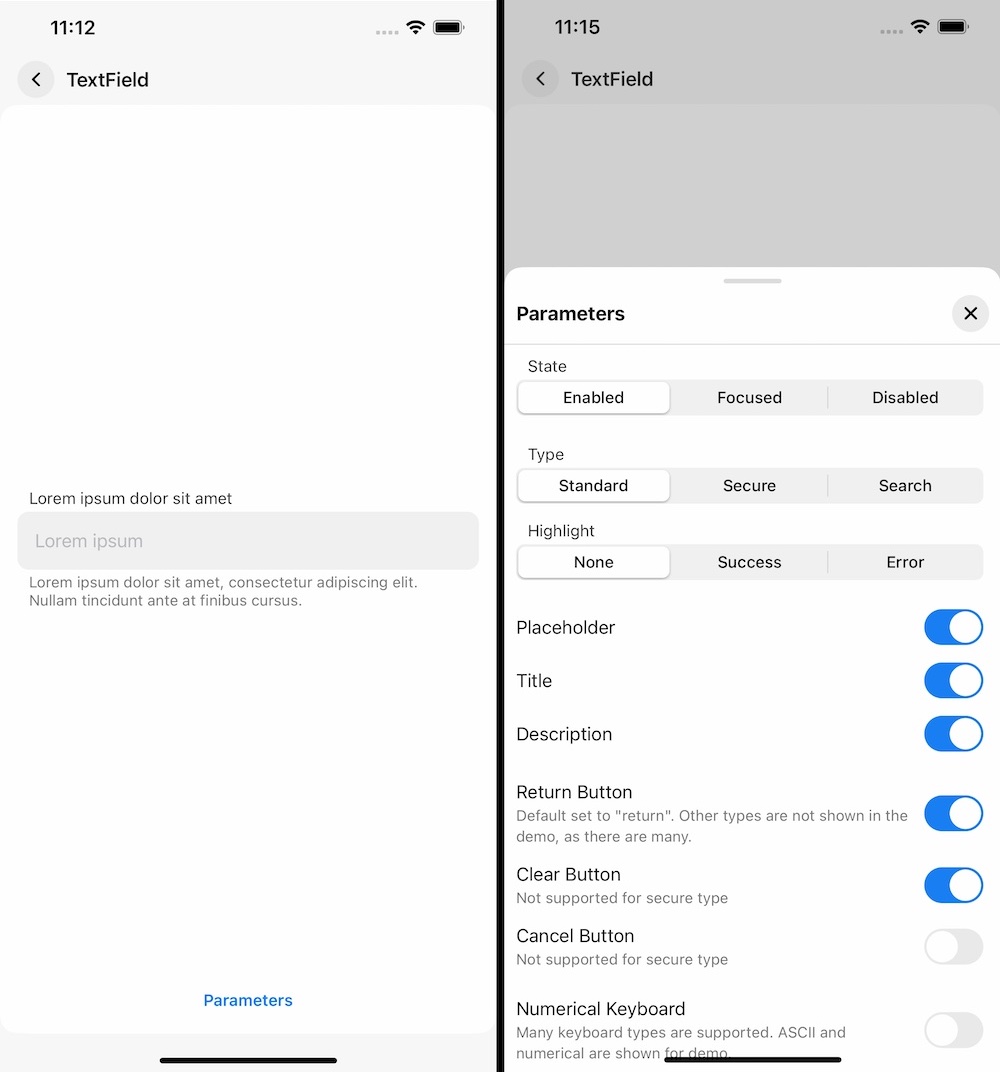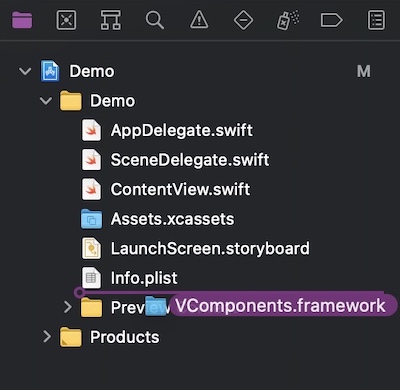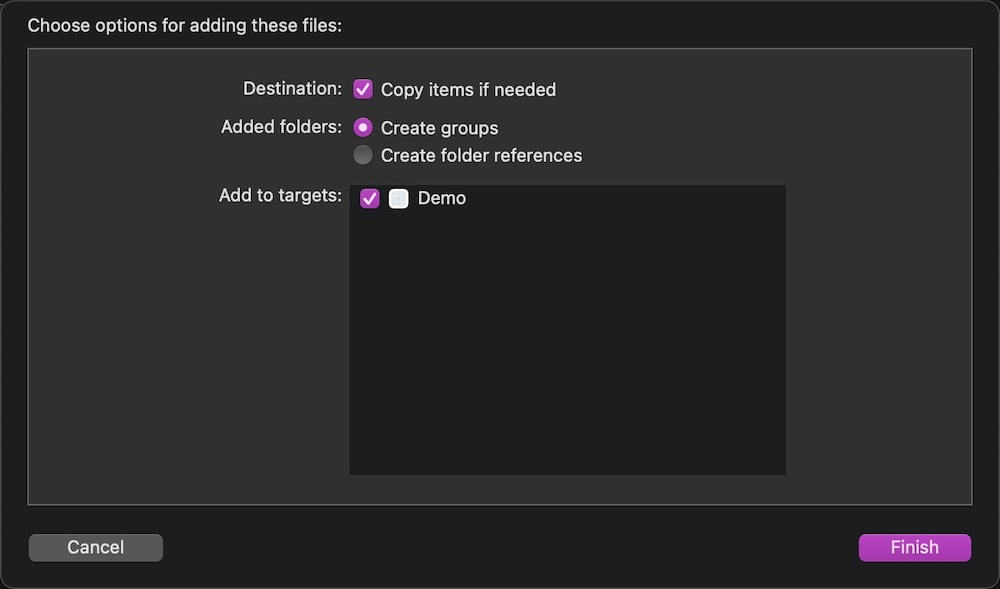VComponents is a SwiftUI framework that contains 40+ customizable UI components.
Framework supports iOS 14.0 and up.
Project is being developed on macOS 11.0 Big Sur in XCode 12.
Project contains demo app, that can be run to showcase all components.
Framework doesn't support Swift Package Manager, CocoaPods, or Carthage.
-
Download VComponents and extract the zip.
-
Drag
VComponents.frameworkinto your project.
Make sure "Copy items if needed" is selected and click Finish.
- Go to the target settings for your app, under "General" tab, find "Frameworks, Libraries, and Embedded Content". Set the VComponents.framework to “Embed & Sign”.
Since VComponents is open-source, you can clone the project and build the framework target yourself.
Buttons. VPrimaryButton, VSecondaryButton, VSquareButton, VPlainButton, VChevronButton, VCloseButton, VNavigationLink, VLink
State Pickers. VToggle, VCheckBox, VRadioButton
Item Pickers. VSegmentedPicker, VMenuPicker, VWheelPicker
Value Pickers. VStepper, VSlider, VRangeSlider
Inputs. VTextField
Containers. VSheet, VSection, VTable, VAccordion
Navigation. VTabNavigationView, VNavigationView
Modals. VModal, VHalfModal, VSideBar, VDialog, VMenu, VActionSheet
Messages. VToast
Indicators. VSpinner, VProgressBar, VPageIndicator
Core. VText, VBaseButton, VBaseTextField, VLazyList, VBaseList, VBaseView
Components are not meant to be customized like you would a native SwiftUI component.
Instead, model can be passed as parameter via initializers. This parameter has default value, and is not required every time you create a view.
Essentially, Models are structs with default values. They usually break down into 5 sub-structs: Layout, Colors, Fonts, Animations, and Misc.
For instance, changing foreground color of VSecondaryButton can be achieved by passing a custom model.
Not Preferred:
var body: some View {
VSecondaryButton(
action: { print("Pressed") },
title: "Lorem ipsum"
)
.foregroundColor(.black)
}Preferred:
let model: VSecondaryButtonModel = {
var model: VSecondaryButtonModel = .init()
model.colors.textContent = .init(
enabled: .black,
pressed: .gray,
disabled: .gray
)
return model
}()
var body: some View {
VSecondaryButton(
model: model,
action: { print("Pressed") },
title: "Lorem ipsum"
)
}Alternately, you can create static instances of models for reusability.
var body: some View {
VSecondaryButton(
model: .myCustomModel,
action: { print("Pressed") },
title: "Lorem ipsum"
)
}
extension VSecondaryButtonModel {
static let myCustomModel: VSecondaryButtonModel = {
var model: VSecondaryButtonModel = .init()
model.colors.textContent = .init(
enabled: .black,
pressed: .gray,
disabled: .gray
)
return model
}()
}Some components take type as parameter. Types are represented as enums, as more can be added in the future.
For instance, VPageIndicator has three types: Finite, Infinite, and Auto. Unlike models, types may be required in some instances. For other enums, a default case is provided.
var body: some View {
VStack(content: {
VPageIndicator(type: .finite, total: 9, selectedIndex: 4)
VPageIndicator(type: .infinite(), total: 99, selectedIndex: 4)
VPageIndicator(type: .auto(), total: 99, selectedIndex: 4)
})
}VComponents approaches animations as bound to components and their models, and not to state. Which means, that to modify a state of component with an animaton, you need to pass a custom model.
Not Preferred:
@State var isOn: Bool = false
var body: some View {
VStack(content: {
VToggle(isOn: $isOn, title: "Lorem ipsum")
VSecondaryButton(
action: { withAnimation(nil, { isOn.toggle() }) },
title: "Toggle"
)
})
}Preferred:
@State var isOn: Bool = false
let model: VToggleModel = {
var model: VToggleModel = .init()
model.animations.stateChange = nil
return model
}()
var body: some View {
VStack(content: {
VToggle(model: model, isOn: $isOn, title: "Lorem ipsum")
VSecondaryButton(
action: { isOn.toggle() },
title: "Toggle"
)
})
}First method is not only not preferred, but it will also not work. Despite specifying nil to chagne state, VToggle would use still use its default animation.
Components manage state parameters internally, and animations used to change them externally do not have any effect.
Thought process behind his design choice was to centralize animations to model.
Components also prevent themselves from modifying external state with an animation.
e-mail: vakho.kontridze@gmail.com
MIT License
Copyright (c) 2021 Vakhtang Kontridze
Permission is hereby granted, free of charge, to any person obtaining a copy of this software and associated documentation files (the "Software"), to deal in the Software without restriction, including without limitation the rights to use, copy, modify, merge, publish, distribute, sublicense, and/or sell copies of the Software, and to permit persons to whom the Software is furnished to do so, subject to the following conditions:
The above copyright notice and this permission notice shall be included in all copies or substantial portions of the Software.
THE SOFTWARE IS PROVIDED "AS IS", WITHOUT WARRANTY OF ANY KIND, EXPRESS OR IMPLIED, INCLUDING BUT NOT LIMITED TO THE WARRANTIES OF MERCHANTABILITY, FITNESS FOR A PARTICULAR PURPOSE AND NONINFRINGEMENT. IN NO EVENT SHALL THE AUTHORS OR COPYRIGHT HOLDERS BE LIABLE FOR ANY CLAIM, DAMAGES OR OTHER LIABILITY, WHETHER IN AN ACTION OF CONTRACT, TORT OR OTHERWISE, ARISING FROM, OUT OF OR IN CONNECTION WITH THE SOFTWARE OR THE USE OR OTHER DEALINGS IN THE SOFTWARE.



